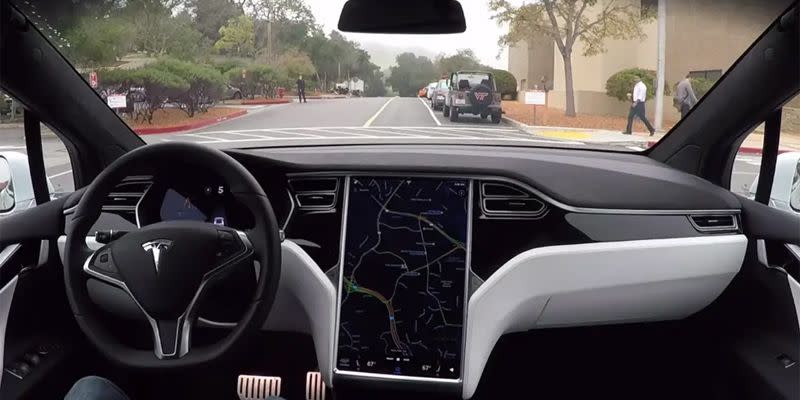Feds Give Self-Driving Car Makers the Hands-Off Treatment

The U.S. government will remove requirements for steering wheels, mirrors, and other safety equipment to speed the development of automated vehicles and make it even easier for automakers and tech companies to test their prototypes on public roads.
Speaking in Washington on Thursday, transportation secretary Elaine Chao introduced new voluntary guidance, dubbed AV 3.0, that attempts to unify all federal agencies on autonomous-vehicle policy. Major rules that currently block manufacturers like Cruise Automation from certifying autonomous cars for sale will be changed. That means steering wheels, pedals, mirrors, and other required equipment will be either loosely defined or entirely optional.
"NHTSA's current safety standards constitute an unintended regulatory barrier to innovation," the report said.
In the report, the DOT clarified that in future rulings it will define "driver" and "operator" as either a human driver or an automated driving system. It will also eliminate the public comment period on requests from manufacturers to waive certain requirements of the Federal Motor Vehicle Safety Standards.
Due to arguments over sharing radio frequencies, the DOT said that automakers can launch automated vehicles without the "precondition" of first establishing a working vehicle-to-vehicle (V2V) network. A V2V standard, whether using the 5.9-Ghz spectrum or a 5G cellular network, has not emerged, even as some companies including Mercedes-Benz have introduced their own proprietary networks. Experts are split on whether V2v-essentially the ground version of air-traffic control-is absolutely necessary for automated-vehicle safety, although no one applauds in-vehicle sensors for being foolproof. To that end, the DOT estimates there are more than 70 sites using vehicle-to-X communication wherein municipal traffic systems connect with cars. By 2020, it wants to install 2100 signal timing devices in 45 cities so that, for example, automated cars could sync their speeds with green lights.
"It will not be top-down command and control," Chao said. "The government is not the best place to choose which technology to succeed and which technology to fail. Consumers will ultimately decide which technology or package of technologies suits them best."
The DOT, which in January designated 10 sites as proving grounds, no longer cares where companies test automated vehicles. As before, automakers and tech companies won’t be required to follow any rules. Everything is voluntary, including the safety reports that NHTSA calls Voluntary Safety Self-Assessments. Only four companies-GM, Ford, Waymo, and Nuro-have bothered filing them, and those appear more like PowerPoint presentations than official documents. Uber, which had a vehicle involved in an accident in March that killed a cyclist in Arizona during public-road testing, has not filed any. Dozens of companies are running public tests without any oversight. Yet Chao said these companies, not federal agencies, must convince Americans the technologies are safe.
"That's why I have consistently challenged the high-tech companies to step up and address the public's legitimate concerns about the safety, security, and privacy of this new technology," she said. "Without public acceptance, the full potential of these technologies will never be realized."
Stiff rules still apply to commercial trucking. The AV 3.0 guidance says that even if some rules (like alcohol testing) won't apply to automated trucks, the Federal Carrier Motor Safety Administration will retain all rights to inspect, regulate, and enforce automated systems on trucks and shut down companies that don’t comply. Transit agencies must submit safety plans and adopt them by July 2020, while automated buses will be studied in pilot programs over the next five years. Even truckers waiting at ports to pick up and drop off cargo-often for hours on end-could be reprieved by automated trucks in these facilities.
Under the new guidance, commercial trucks, ports, transit buses, and railways must begin developing plans for self-driving technology. Among its goals to accelerate "technology neutral" innovation without any formal rulemaking, the Department of Transportation is requiring outside agencies to cooperate with a fully-automated future. The Department of Labor will study how automation will affect driving jobs, the Department of Homeland Security needs to provide tips on vehicle cybersecurity, and the Federal Trade Commission has to ensure vehicle owner data isn't abused.
The United States has no formal statutes permitting or prohibiting automated vehicles. Since the DOT released initial guidelines for autonomous vehicles under President Obama in 2013 and 2016 and a second version last September, the government's do-whatever-you-want consensus remains: States should follow recommendations from the federal government when drafting legislation, while manufacturers should follow any standard they like, preferably those set by industry organizations like the engineering group SAE International. Look for those groups, not government, to write the rule book.
('You Might Also Like',)

 Yahoo Autos
Yahoo Autos 